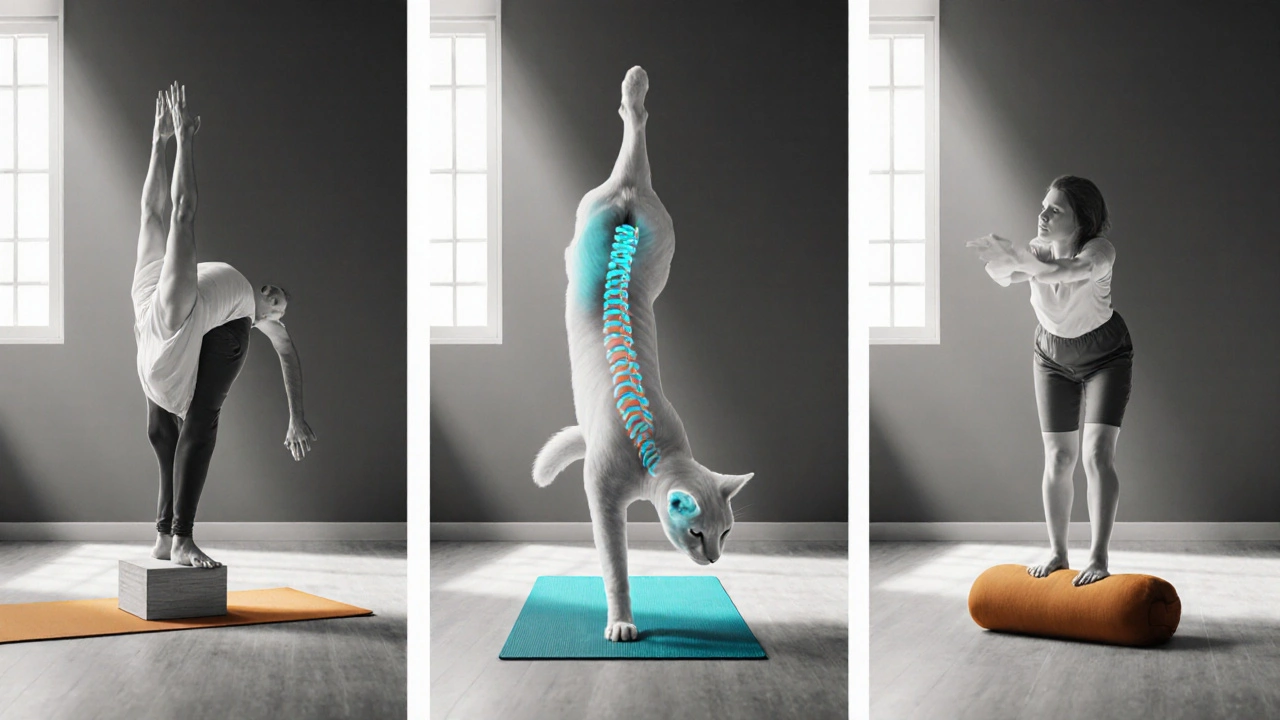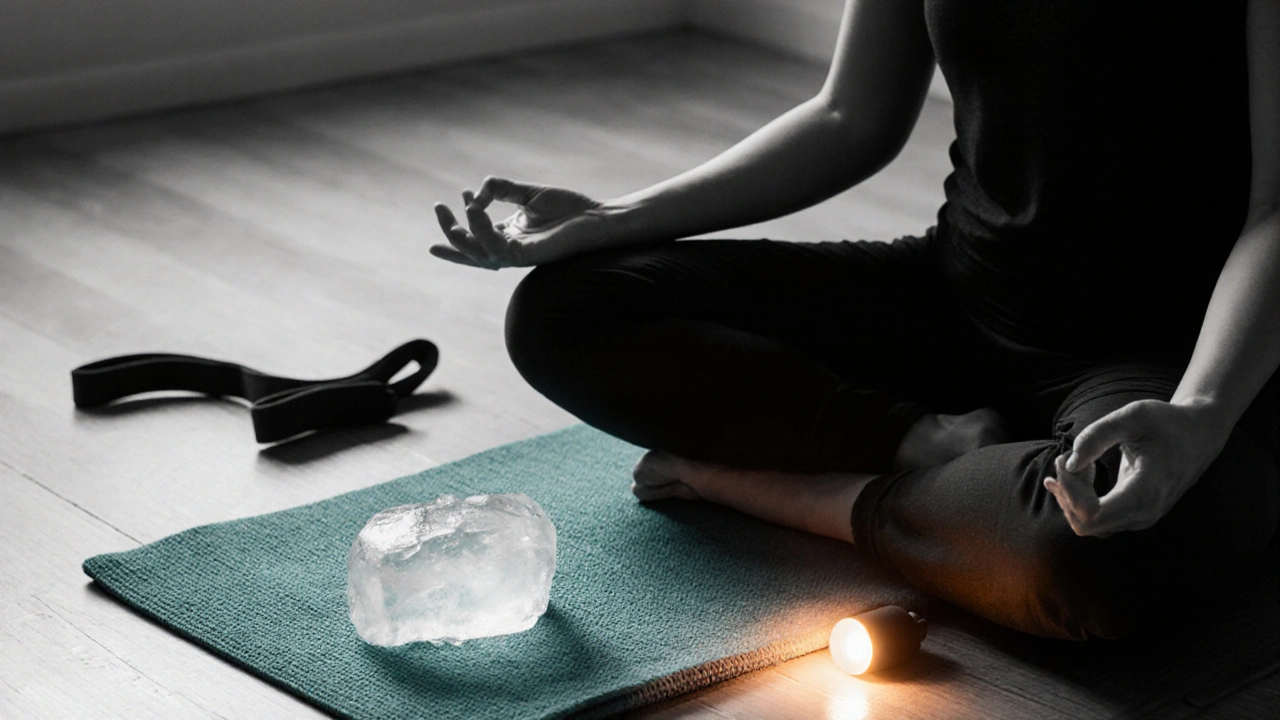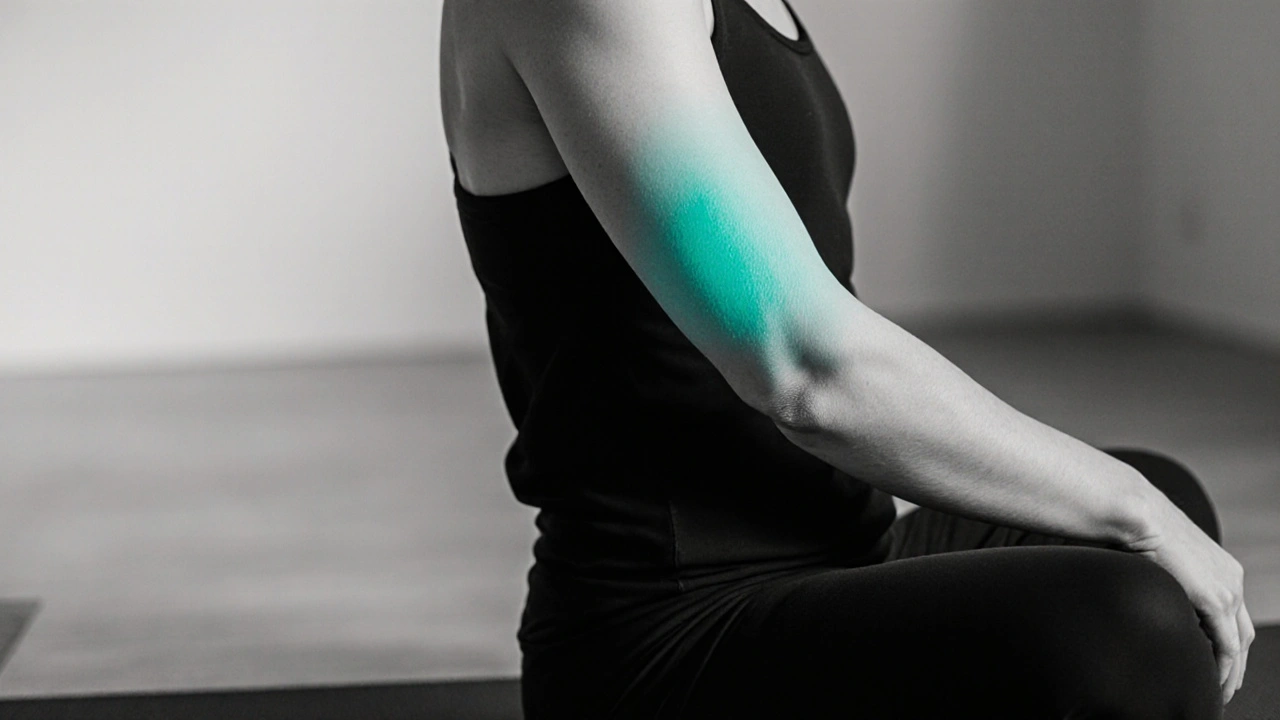Bursitis Relief Yoga Pose Recommender
Choose your bursitis location to get personalized yoga recommendations.
When you hear the word Bursitis is a painful inflammation of a bursa, the fluid‑filled sac that cushions bones, tendons and muscles near joints, you might think it only affects athletes. In reality, anyone can develop it, especially around the shoulder, hip or knee.
Enter Yoga is a mind‑body practice that blends physical postures, breath work and meditation to improve flexibility, strength and stress management. The question on many people’s minds: can this gentle practice actually help with bursitis pain?
Quick Takeaways
- Yoga can improve joint range of motion without stressing inflamed bursae.
- Choose low‑impact poses that target the affected area and avoid deep compression.
- Combine yoga with ice, rest and, if needed, NSAIDs for faster bursitis pain relief.
- Listen to your body - sharp pain means you should stop the pose.
- Consult a healthcare professional before starting a new routine.
What Is Bursitis?
A Bursa is a small, fluid‑filled sac that acts as a cushion between bone and soft tissue. When repetitive motion, a sudden injury, or infection irritates this sac, the lining swells, leading to Inflammation that can cause sharp pain, stiffness and reduced mobility.
The most common sites are:
- Shoulder (subacromial bursa)
- Hip (trochanteric bursa)
- Knee (pre‑patellar and olecranon bursae)
Typical triggers include repetitive overhead work, long periods of kneeling, or even prolonged sitting that puts pressure on the hip bursa.
How Yoga Can Help
Yoga isn’t a magic cure, but its combination of gentle stretching, controlled strengthening, and breath awareness can address three key factors that keep bursitis flaring:
- Improved circulation - Deep, rhythmic breathing encourages blood flow, delivering nutrients that aid tissue repair.
- Increased joint mobility - Slow, mindful movements keep the surrounding muscles supple, reducing the load on the bursa.
- Stress reduction - Lower cortisol levels can diminish systemic inflammation.
Crucially, yoga allows you to stay in a pain‑free range of motion, unlike high‑impact sports that might aggravate the inflamed sac.

Safe Yoga Poses for Common Bursitis Sites
| Pose | Target Bursitis Site | Modifications / Tips |
|---|---|---|
| Thread the Needle | Shoulder | Knee on mat, slide arm gently across body; keep elbow slightly bent to avoid deep compression. |
| Supported Bridge (Setu Bandhasana) | Hip | Place a block under sacrum for a milder stretch; engage glutes lightly, no pushing through the hips. |
| Standing Quad Stretch (with hand on wall) | Knee (pre‑patellar) | Keep knee slightly bent, avoid pulling the foot behind you if it hurts; use a strap. |
| Cat‑Cow (Marjaryasana‑Bitilasana) | General joint mobility | Move slowly, focus on fluid spine motion; stop if any sharp pain appears. |
| Child’s Pose (Balasana) | Lower back & hip bursae | Spread knees wide to reduce pressure on the hip bursa; place a bolster under chest for extra support. |
Sample 15‑Minute Yoga Routine
- Start with 2 minutes of seated deep breathing (Sukhasana). Inhale to lengthen the spine, exhale to release tension.
- Gentle neck rolls - 5 slow circles each direction, keeping movement within a comfortable range.
- Thread the Needle - hold each side for 30 seconds, breathing into the shoulder.
- Supported Bridge - lift hips onto a block, hold for 45 seconds; focus on engaging glutes, not pushing the hips too high.
- Standing Quad Stretch - 30 seconds per leg, using a wall for balance.
- Cat‑Cow - flow for 1 minute, synchronizing breath with spinal movement.
- Child’s Pose - sink into the pose for 1 minute, allowing hips to gently stretch.
- Finish with 2 minutes of seated meditation, noticing any lingering sensations.
Repeat the routine 3‑4 times a week, gradually extending hold times as comfort improves.

Precautions - When Yoga Might Not Be Right
- If you feel a sharp, stabbing pain, stop the pose immediately. Discomfort that eases with gentle stretch is okay; pain is a warning sign.
- Avoid deep overhead work (e.g., full wheel) when shoulder bursitis is active, as it compresses the subacromial space.
- Skip any pose that forces the joint into a fully extended position if swelling is present.
- Consult a physician if bursitis is accompanied by fever, redness, or drainage - these may indicate infection.
Complementary Therapies
Yoga works best when paired with other evidence‑based treatments:
- Ice therapy: Apply a cold pack for 15‑20 minutes after a session to curb inflammation.
- Non‑steroidal anti‑inflammatory drugs (NSAIDs): Short‑term use can reduce pain; always follow dosing guidelines.
- Physical therapy: A therapist can teach you targeted strengthening exercises that protect the bursa.
- Rest & activity modification: Give the inflamed area at least 48 hours of reduced load before returning to full activity.
Frequently Asked Questions
Can I do yoga every day if I have bursitis?
Gentle, low‑impact sessions (15‑20 minutes) are fine daily, but give inflamed joints extra rest on days you feel sharp pain. Listen to your body and vary poses to avoid over‑loading one area.
Should I avoid all standing poses?
Not necessarily. Standing poses that keep the joint in a neutral position, like Mountain Pose with slight knee bend, are usually safe. Avoid deep lunges or high knee lifts that compress the bursa.
How long before I feel improvement?
Most people notice reduced stiffness within 1‑2 weeks of consistent practice, but full pain relief can take 4‑6 weeks, especially when combined with ice and NSAIDs.
Is yoga safe for bursitis caused by infection?
If an infection is present, avoid all exercise until a doctor clears you. Stretching a septic bursa can spread bacteria.
Do I need special equipment?
A yoga mat, a sturdy block or bolster, and a strap are enough. Props help keep poses pain‑free and provide support where the bursa is tender.
Can yoga prevent future bursitis episodes?
Yes. Regular yoga maintains flexibility and balanced muscle strength, which reduces abnormal joint stress - a common cause of recurring bursitis.
Should I combine yoga with other exercises?
Low‑impact cardio (like walking or swimming) pairs well with yoga. Avoid high‑impact activities (running, jumping) while the bursa is inflamed.


Patricia Echegaray
October 16, 2025
Yoga studios suddenly pop up on every corner, pushing "natural healing" like a secret government agenda. They’re not just selling mats; they’re funneling us into a wellness monopoly backed by big‑pharma investors who want us dependent on supplements. The breath work is a clever disguise for subtle mind‑control techniques that keep the masses compliant. So before you roll out that fancy block, consider who’s really profiting from your supposed "pain relief".
Kevin Adams
October 21, 2025
Behold the humble stretch, a silent ode to the cosmos, a breath that whispers the meaning of existence-yet we dare to label it merely "exercise". The very act of bending a knee becomes a rebellion against the gravity of our doubts. And so we stretch, we breathe, we seek-oh, the drama of the everyday! Let the mat become a stage, the body a protagonist, and the pain a fleeting antagonist.
In this grand theater, every exhale is a curtain call.
CHIRAG AGARWAL
October 26, 2025
Honestly, this whole yoga‑for‑bursitis hype feels like a lazy shrug from the fitness industry-just another buzzword to sell overpriced leggings. I’m not convinced a few gentle poses will magically erase months of inflammation, especially when the advice is riddled with vague "listen to your body" clichés. Could we maybe get some real science instead of this feel‑good fluff?
genevieve gaudet
October 31, 2025
i get ur point but think bout how stretchin can open up new pathways in the mind-kinda like tradin stories across cultures. Even if u think it’s fluff, many ages have used pose as a meditative tool that calms the nervous system, which can, in turn, lower inflammation. didnt u ever read about the ancient ayurvedic texts? they talk bout "svastha" meaning health of the whole being.
Katie Henry
November 4, 2025
Dear readers, it is with great enthusiasm that I encourage you to incorporate these gentle yoga sequences into your recovery regimen. Consistency, paired with mindful breathing, will foster both physical resilience and mental fortitude. Please proceed with caution, honoring your body's signals at every stage of practice. May your journey toward relief be both safe and rewarding.
Joanna Mensch
November 9, 2025
Somehow I suspect the “mindfulness” hype is a covert operation to keep us docile, a silent agenda to divert attention from more insidious health threats.
Nickolas Mark Ewald
November 14, 2025
Thanks for the clear guide.
Chris Beck
November 19, 2025
The article tries to sound expert but it’s just fluff. Yoga won’t fix bursitis unless you stop moving altogether. People need real medical advice, not these trendy poses.
Tom Green
November 24, 2025
While it’s true that professional guidance is essential, many find that gentle yoga complements conventional treatment by improving circulation and reducing stiffness. Sharing experiences can help others discover safe modifications that work with their therapy plans.
Emily Rankin
November 28, 2025
The notion that yoga can aid bursitis relief resonates deeply with the human quest for harmony between body and spirit. First, the deliberate focus on breath heightens oxygen delivery, which is a vital catalyst for tissue repair. Second, the slow, controlled movements ensure that surrounding muscles are conditioned without overloading the inflamed bursa. Third, the mindfulness cultivated during practice can lower cortisol, the stress hormone notorious for aggravating inflammation. Moreover, the routines presented are deliberately low‑impact, respecting the delicate nature of the affected joints. As you settle into Thread the Needle, you invite the shoulder to glide gently, releasing tension without compression. The Supported Bridge, when executed with a block, offers a subtle hip opening while sparing the trochanteric bursa. Standing Quad Stretch, performed with a wall, stabilizes the knee and promotes circulation without strain. Cat‑Cow encourages spinal articulation, a universal benefit that supports overall joint health. Even Child’s Pose, with a bolster, provides a restorative haven for the hips and lower back. Consistency, as the article underscores, is the key-regular fifteen‑minute sessions can produce noticeable improvements within weeks. Yet patience remains paramount; the body’s healing timeline cannot be rushed. Pairing these sessions with ice therapy accelerates inflammation reduction, creating a synergistic effect. Finally, listening to subtle body cues transforms the practice from a mere exercise into a compassionate dialogue with oneself. Embrace this holistic approach, and you may discover not just pain relief, but a renewed sense of vitality.
Rebecca Mitchell
December 3, 2025
i love the detail but be careful not to overdo it. keep it gentle.
Roberta Makaravage
December 8, 2025
Let me be crystal clear: the science is unequivocal-yoga, when done correctly, accelerates bursitis recovery, no doubt about it 😇. The combination of controlled stretching and diaphragmatic breathing creates a cascade of anti‑inflammatory signals. If you ignore these proven benefits, you’re essentially choosing stagnation over progress. Trust the evidence, trust the practice, and you’ll see the results. 🌟
RJ Samuel
December 13, 2025
Oh sure, “crystal clear” as you say, but the same “proven” studies might be funded by yoga outfitters looking to pad their wallets. Just a thought, mate.